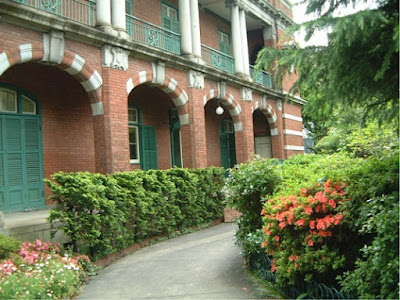I visited the museum and cemetery one sun-washed morning in late August this year. Among the displays in the museum were drawings done by children on their way to and in the concentration camps, brightly colored at first but increasingly dark and desperate. The cemetery, which visitors pass on their way out of the complex, is remarkable for its hundreds of gravestones of varying age literally squeezed together and piled on top of each other to save space. It was here that I noticed connections with Nagasaki.
Although not widely known, Nagasaki had a small but prosperous Jewish community around the turn of the 20th century. Jews of various nationalities including Russia, Austria, Romania and Turkey began to arrive here after the Meiji Restoration of 1868. Many opened bars, tailor shops and stores on the back streets of the foreign settlement; others like Morris Ginsburg and Sigmund Lessner established successful businesses and contributed to the development of Nagasaki as an international port.
In 1892, Ginsburg led the Jewish community in purchasing space for a Jewish burial ground in the newly opened Sakamoto International Cemetery. The plot was located at a prime location near the cemetery entrance and featured a distinctive stone gate and walls with a cast-iron fence. The number of burials increased in proportion to Nagasaki's activity as a port, so rapidly in fact that the plot, just like the Jewish cemetery in Prague, became full and any new gravestone had to be placed in the aisles or between existing gravestones.
Nagasaki was also the site of Japan’s
first synagogue. In September 1896, Sigmund
Lessner joined with Haskel Goldenberg and other prominent Jewish entrepreneurs
in establishing the Beth Israel Synagogue at No.11 Umegasaki, a single-story brick building featuring Japanese-style ceramic
roof tiles and distinctive pear-shaped window awnings. The synagogue bustled with residents and
visitors during the busy years around the turn of the century. In 1901, Lessner also founded local branches of the Jewish Benevolent Society and the
Anglo-Jewish Association.
Lessner managed to revive his store and auction business after the war, but his sudden death in 1920 -- along with other factors including the rising cost of living in Japan and Nagasaki's decline as a venue for foreign trade -- precipitated a sharp drop in the number of Jewish residents. By 1924, most of the Jewish businesses in the port had closed. The Beth Israel Synagogue came under the administration of a Jewish organization in Shanghai and was sold off and converted into a warehouse. By the time the atomic bomb explosion smashed windows and tore tiles off the rooftops of the Umegasaki neighborhood, few people even remembered the original function of the odd-looking building.
Today, the former Jewish quarters of Prague and other European cities are gone, and the descendants of the people who thrived and suffered there are scattered around the world. In Nagasaki, the only reminder of the former Jewish community is a few inscriptions on gravestones in Sakamoto International Cemetery -- and the stories tucked away in the heart of an international port.
The old Jewish Cemetery in Prague, Czech Republic.
The Jewish section of Sakamoto International Cemetery in Nagasaki, seen from the rear. Like its counterpart in Prague, the plot is congested with gravestones. At the front is a gate with an inscription in Hebrew and the year 5653, equivalent to 1892, carved on one of the pillars.
The Jewish section of Sakamoto International Cemetery in Nagasaki, seen from the rear. Like its counterpart in Prague, the plot is congested with gravestones. At the front is a gate with an inscription in Hebrew and the year 5653, equivalent to 1892, carved on one of the pillars.
(Left) A gravestone in the old Jewish Cemetery of Prague shows a pair of hands carved in relief, a symbol of priestly blessing. (Right) The same symbol is evident on a gravestone in the Jewish section of Sakamoto International Cemetery in Nagasaki.
The Beth Israel Synagogue was built in the rear portion of No.11 Umegasaki in 1896, the first Jewish place of worship in Japan. The single-story brick building (right) had high shuttered windows with characteristic pear-shaped awnings.
Woodblock print by Nagasaki artist Tagawa Ken (1906-1967) depicting the former Beth Israel Synagogue in Umegasaki. Tagawa was fascinated by the buildings of the Nagasaki Foreign Settlement, abandoned but still exuding the atmosphere of an age gone by.
After being sold off by auction in 1924, the former synagogue was used as a warehouse until finally falling to the wrecker's hammer in the 1960s. All that remain today are a few of the stone structures nearby: the stairs leading up the hillside and parts of the gutter and embankment wall to the left.
Small bronze plaque implanted on the sidewalk in front of a house on a busy shopping street in Amsterdam. A man named Abraham Bilderbeek lived there with his family until being arrested by the Nazi Gestapo and dragged to the Auschwitz death camp -- for what possible crime or infraction?
Your writer walking in front of Anne Frank House on the Prinsengracht canal in Amsterdam in early September 2012, trying to figure the whole thing out.

















